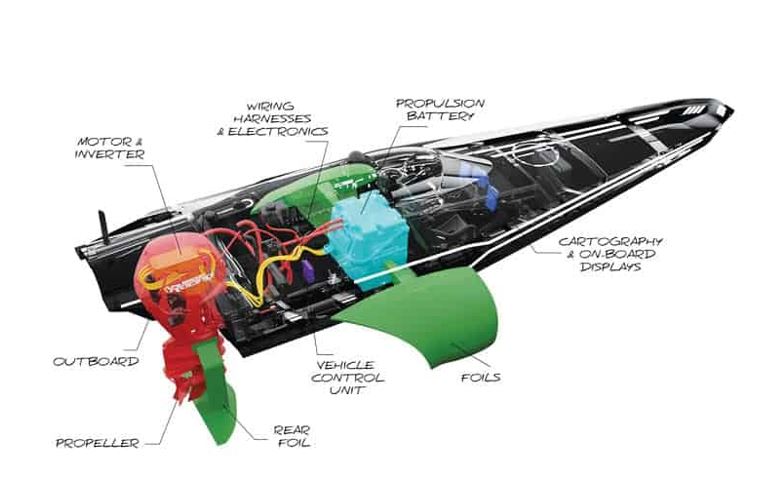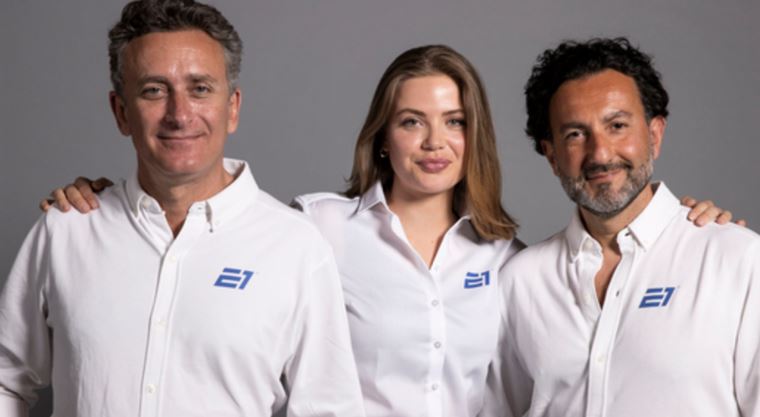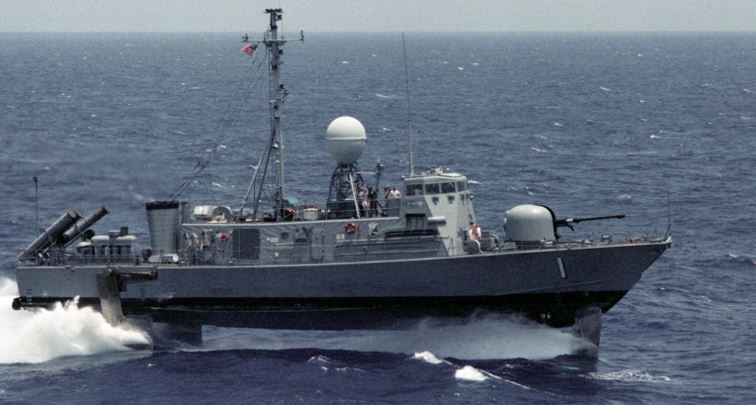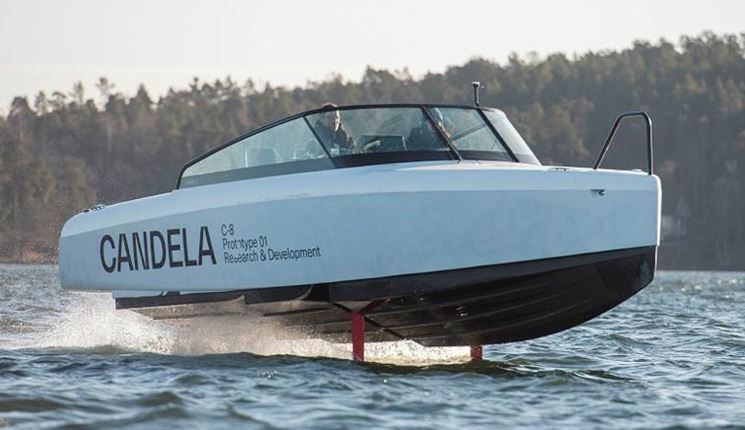Mercury Embraces Electric Boat Racing
Mercury Racing E1-X
Mercury Marine has a long history of promoting racing as a platform to both promote and test their products. Not surprisingly, it has once again turned to that venue for a dramatic entry into the world of electric boat propulsion by getting in on the ground floor of a new and exciting world-wide racing concept. Modeled on the template of Formula 1 auto racing that has design rules for the vehicles and schedules an annual series in high-profile locations around the world, the new “E1 World Championship” has the same sports-promotion ambition.
Chairman and co-founder of the E1 World Championship is Alejandro Agag, a pioneer in sustainable electric motorsport. He ran a successful; GP2 team in Formula 1’s main support series, which inspired him to build two electric championships from scratch, Formula E and Extreme E.
Co-founder and CEO is Rodi Basso, an aerospace engineer involved with motor racing and business development for McLaren Applied Technologies. Mercury Racing will be providing the propulsion system engineering, including the electric motor. By rule, the boats will be powered by a 520-pound Kreisel 35 kWh lithium-ion battery and a Mercury Racing E1-X outboard motor with a power output of 150 kW (about 200-hp).
Investors commissioned the design, construction and development of the RaceBird boat to Norwegian designer Sophi Horne, founder of SeaBird Technologies, a Norwegian designer of superyacht interiors, and the originator of the initial RaceBird concept. Victory Marine, will be building the one-design race boats in Europe.
The Mercury Racing division has announced it will be the official “Propulsion and Propeller Partner” backing the E1 World Championship.
The premise of the UIM-sanctioned E1 World Championship is a series of inshore circuit races featuring one-design boats held in high-profile urban venues— Miami, Monaco, Venice, Paris and Manhattan are among the tentative sites.
Testing of the prototype 24’ all-carbon fiber RaceBird boat and Mercury motor has been conducted in Italy, and the race boat fleet is being built this summer, according to the group, with the first race planned for late 2023 at a location to be determined.

The boats will be powered by an electric motor with 150 kW (about 200 hp) power output. Projected top speed is about 58 mph for the initial designs. Hydrofoils attached to the hullsides and the outboard motor lift the boat above the water’s surface, allowing for minimal drag and maximum energy efficiency. The main foils will be fixed, but the aft foil will move with the outboard as it’s trimmed and adjusted for height on the transom, giving the pilot control of boat attitude.
The E1 Motor
The electric outboards designated as the standard powerplant for the racing series will be built on the midsection and gear case of Mercury’s 2.1-liter outboard. The internal combustion powerhead was removed and replaced with the electric motor and an inverter.
The electric motor has a peak speed of about 7,000 rpm, about 1,000 rpm faster than a 2.1-liter internal-combustion engine. The Mercury Racing team selected the 2.07-to-1 gear ratio for the project. The DC-to-AC is positioned on top of the electric motor. The combination of motor and inverter requires less space than the 2.1-liter powerhead.
Keeping It Cool
All that electric power requires cooling, obviously. Three components of the powertrain are water cooled: the electric motor, the inverter, and the 35 kWh battery. Two separate closed-cooling systems and seawater heat exchangers are used for the job.
Mercury Racing devised a seawater pickup port located in each strut of the hydrofoil that is attached to the E1-X motor. Rather than create all-new parts for the cooling system, engineers looked to existing Mercury components. The transmission cooler for a Mercury Verado V-12 outboard serves as the heat exchanger for cooling the motor and inverter. The pressure sensors, temperature sensors, coolant reservoir and other components for the cooling systems are from Mercury Racing QC4 sterndrive engines.
“We were able to develop the E1-X prototype quickly with parts that are on hand and already validated,” says Jeff Broman, Mercury Racing’s director of engineering. “When the final E1-X design is established and we move to regular production, some of these components may be replaced with newly designed parts optimized for size or weight.”
Designing the Foil
Rigging a foil to the outboard was a new challenge for Mercury Racing. Broman says his team was supplied with a CAD file and had to create a prototype foil from billet aluminum. The production foil can be composite. Mercury Racing had to devise a way to secure the foil, which can generate 500 pounds of lifting force, to the motor’s midsection, and also to accommodate the boat’s changing elevation as its speed increases or decreases.
Two 5-inch spacers in the midsection give the E1-X a length of 30 inches, which keeps the prop in the water as the boat lifts on the foils. The motor is also rigged with a hydraulic jack plate with 6 inches of up-and-down range, which allows further fine-tuning of the engine’s height. Broman reports that RaceBird and E1-X testing is ongoing and has been successful so far, focusing mostly on optimizing the hydrofoil system. An E1 Championship boat is expected to make demo runs at the Mercury Racing Midwest Challenge in Sheboygan, Wisconsin, on August 12.
Early entrants into the series include Tennis legend Rafael Nadal, who joins the Venice Racing Team and Team Mexico, whose ownership includes Checo Perez, the Formula 1 driver for Red Bull (auto) Racing. Mercury and the E1 Circuit expect to announce further details of the series early this summer.
Hydrofoils Then and Now
“Hydrofoils” are underwater fins or curved wings designed to lift the hull of a boat clear of the surface when the boat reaches the necessary speed. The concept is to reduce drag on the hull to increase speed and/or fuel efficiency, and at the same time lift the boat above most waves, smoothing the ride by creating a “boat that flies”.
Hydrofoils have been around at least in principle for a hundred years, and there are numerous high-load passenger ferries and military vessels based on the principle in operation today. But they’ve not become a factor in recreational powerboating until very recently, and renewed interest now is going hand in hand with the rise of electric power for boats.
They’re in the boating news right now because Mercury Marine recently announced it would back the E1 Championship, a series of formula-style hydrofoil races with boats powered by their E-1 electric outboards, at a series of races tentatively slated for Miami, Manhattan, Monte Carlo and other big-market venues worldwide. The series has been recognized by the UIM, the Union Internationale Motonautique, which is the international governing body of power boat racing, and is expected to bring a lot of eyeballs to the rapid evolution of powerboats to electric power.
Advantages of Hydro-Foils
Foiling boats have the advantage of escaping the effect of waves as well as greatly reduced drag on the hull. They’ve famously been used on America’s cup sail boats to attain impressive speeds of over 40 knots. And specially built sailboats designed to crack speed records have gone much faster. Australian Paul Larsen and his Sailrocket2 team have achieved an amazing 65.45 knot (75.3 mph) average for a short distance last year, officially becoming the world’s fastest sailboat—and running considerably faster than hydrofoils were thought to be capable of going.
Internal combustion engines have also pushed large foiling boats to impressive speeds, but can e-power on a hydrofoil match the power of fossil fuels—or even the wind? Not yet, but we are only at the beginning of the e-power age, something like the 1896 Benz in terms of internal combustion engines. (Reported top speed on that 3-wheeled ancestor of the Mercedes was 10 mph (16 kmh).







